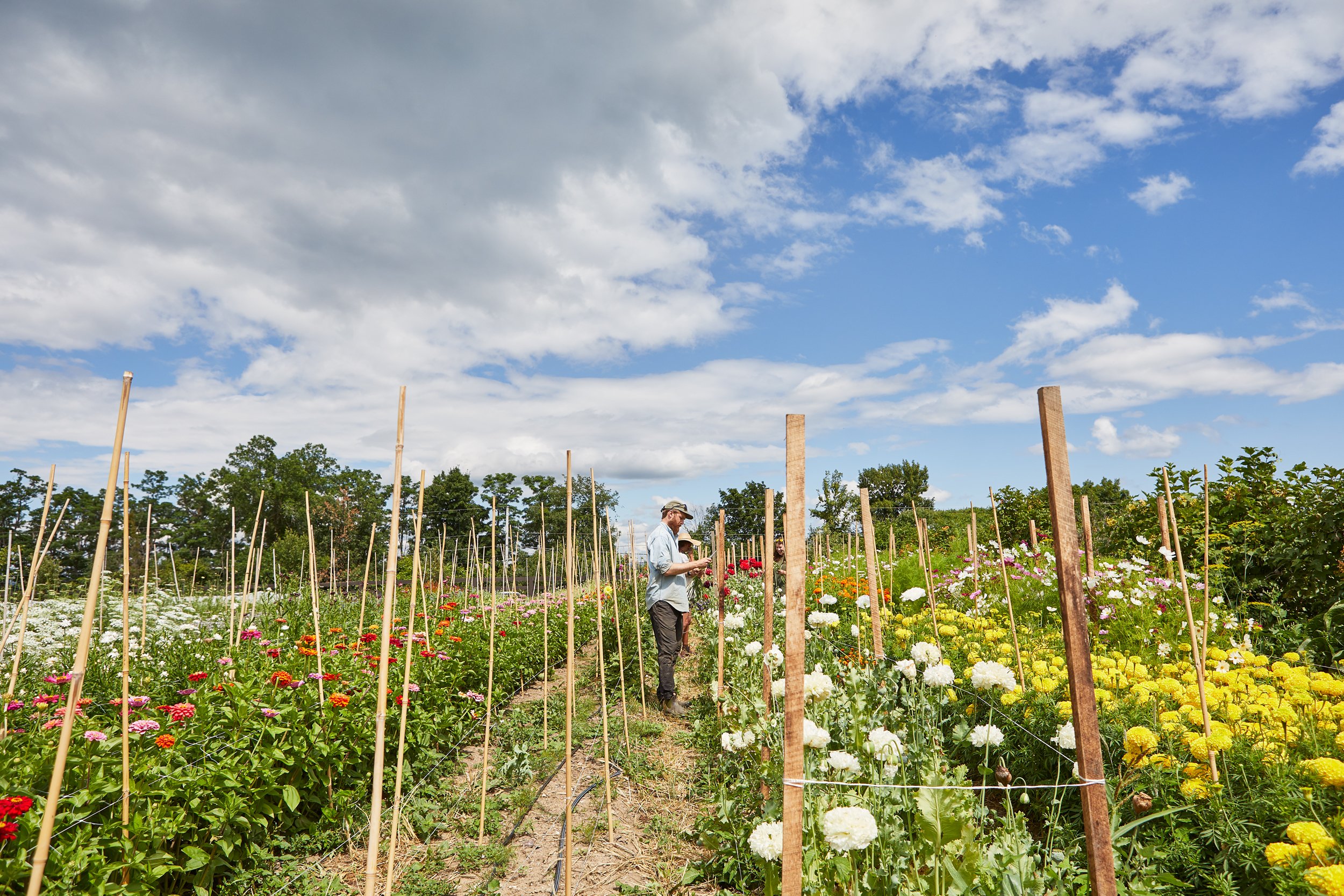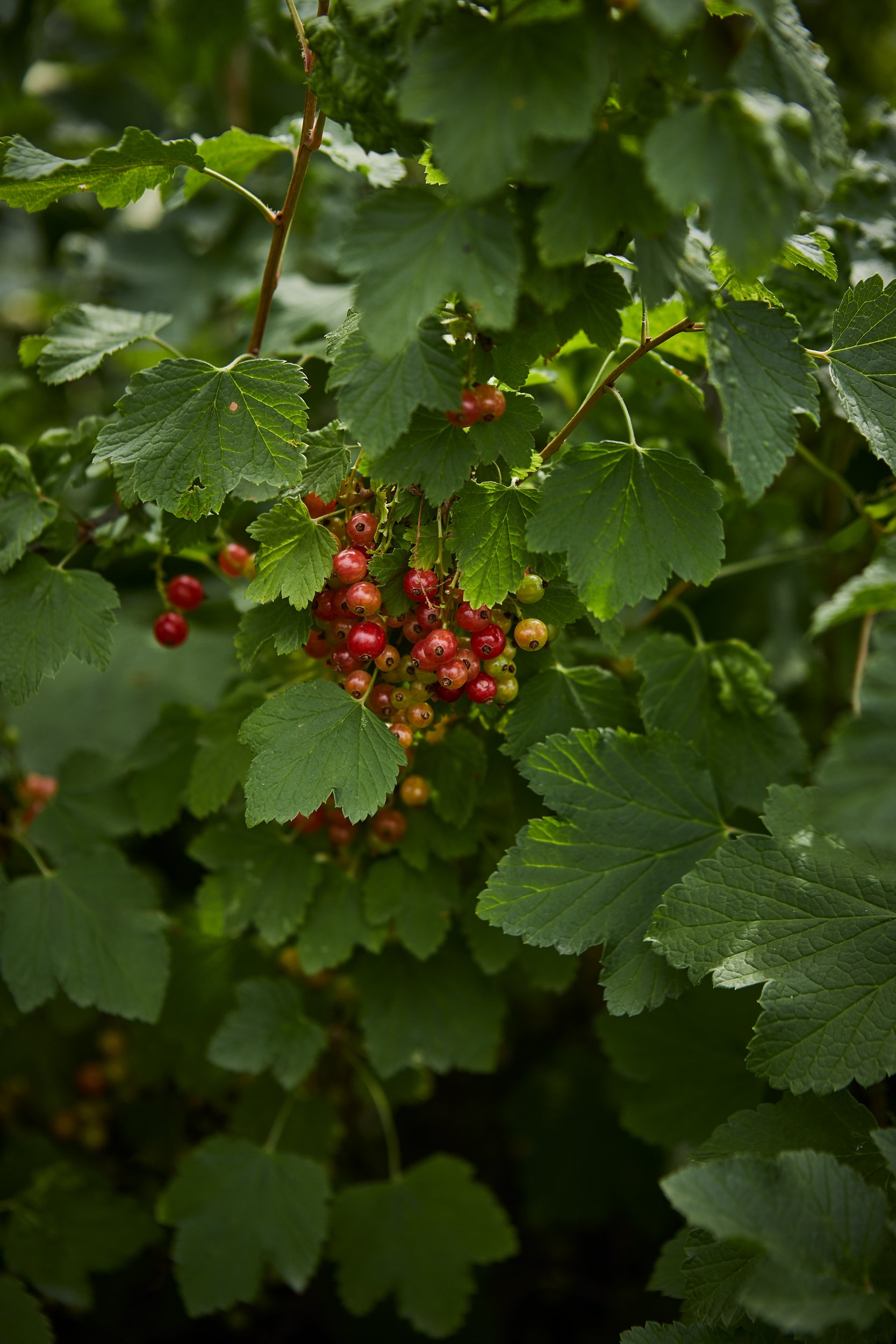How The Garden Grows
Brian and his team harvesting flowers in the Ridge Garden
Market Garden Manager Brian Morgan, who with his team tends the farm’s two-plus acres of organic vegetable, fruit, herb, and flower gardens, meets regularly with the kitchen staff for “talk back” sessions, answering questions and sharing updates about the garden, which they can then in turn share with diners. Earlier this summer, gathered around a bed of Speckled Hound and Porcelain Doll pumpkins, Brian chatted with the staff about how the garden is structured, how much the team experiments, and how they collaborate with the kitchen to produce a diverse menu year-round. Keep reading for highlights from the conversation.
Ecosystems in Balance
The basic structure of the Ridge Garden is made up of eight blocks, each containing ten growing beds. The blocks are separated by buffer zones planted with deeply rooted perennials—primarily native flowers and edibles that thrive in the local climate. These buffer zones promote balance in the garden, supporting more diverse populations of insects and birds than the annual plants would on their own. Brian pointed out, for example, that beetles love cucurbits—the pumpkin family—and that many birds eat beetles. So encouraging bird populations close to the cucurbit beds could help to keep the beetles under control, feed the birds, and increase the chances of a healthy fall harvest of Speckled Hounds and Porcelain Dolls. “The more potential for balance we can bring,” he explained, “the more hope we have that things are healthy.”
Currants growing on the farm
Buffer zones also provide protection from the elements. Nodding to a row of twelve-foot-high shrubs behind him, Brian asked, “Anybody know what these are? They’re elderberries. They’re flowering now, and they’ll probably fruit in August. We get tons of elderberries out of these—but also, we’re on a ridge. Yesterday, there were 30-mile-an-hour winds the whole day. These elderberries provide an amazing wind block for the delicate annual crops in addition to the diversity of life they’re attracting.”
Brian and his team strategically rotate where crops are planted each season. If they planted the pumpkins next to the elderberries again next year, the same insects, many of which can overwinter in the soil, would return in the spring, ready to eat. And large-fruit-producing plants, like nightshades, extract more nutrients from the soil than lettuces. Rotation encourages pest populations to stay in check and each growing bed’s soil gets periodic rests.
Experimentation, Failing, and Learning
No two years on the farm are alike; each is an opportunity to learn. Philo Ridge Farm’s gardens are still young, so the garden team is very hands-on and keeps up a constant conversation about what’s working and what’s not, making adjustments throughout the season.
As in the farm’s pastures, soil health is of top concern in the garden beds, which offers an opportunity to explore how cover-crop diversification can improve soil composition over time. A common goal of cover cropping—the planting of beneficial, non-production crops to improve soil health—is nitrogen fixing. Cover crops like peas and clover deposit nitrogen into the soil, making it more nutrient-rich for the next crop planted. Philo Ridge Farm’s soil benefits from nitrogen-fixing, but the farm’s history presents an additional challenge. Because the soil once supported a conventional dairy farm with heavy animal presence and infrastructure, “this area is super high in phosphorus,” Brian explained. “Often, where there are concentrated cows, there will be high phosphorus.”
“No two years on the farm are alike; each is an opportunity to learn.”
He pointed to a garden bed that had been kept in cover crops for over a year. First, phosphorus-scavenging buckwheat, sunflowers, and scarlet runner beans were planted to reduce the phosphorus levels. Then the garden team planted rye to help break up the soil, compacted from years of conventional plowing. “We still needed to add compost on top,” Brian said. “Even the diversity of cover crops doesn’t mean for sure we’re going to be able to work with it.” But they’re always “trying to push the envelope and explore.” What matters at the end of the day, Brian said, is how the soil feels.
Of course, nature keeps the team on their toes. For example, in May, just as the bok choy, a brassica, was coming up, flea beetles—tiny, hopping black beetles that love to eat brassicas, leaving tiny pinholes—came out in large numbers. “They went right for the bok choy.” Brian considered pulling the crop, but then a few 90-degree days hit in mid-May. “Flea beetles don’t like serious heat, so the population dropped dramatically without us doing anything. And then the bok choy continued growing happily. That was a very cool ‘a-ha’ moment—sometimes nature just runs its course and takes care of itself.”
Kitchen Collaboration
Everything grown in the farm’s gardens is destined for the Market and kitchen, so deep collaboration is key to both teams. “We’re growing 280 varieties total this year,” Brian said.
The kitchen and garden teams push each other in ways that ultimately improve the farm and food it serves. The needs and constraints of the garden push the kitchen to be creative. Crops that grow well and promote the overall health of the farm’s ecosystems get priority, and so the kitchen innovates to make good use of them.
Chef Kevin in the greenhouse with Brian
The teams also collaborate on choosing varieties that will preserve and store well, ensuring the kitchen has plenty of flavors to play with as late-fall sunlight drops too low to support much growth. “We have two varieties of paste tomatoes—San Marzanos and a variety called Midnight Roma. Both of those are intended for canning,” Brian told the group. “There’s a variety of cabbage called Murdoc that’s a great kraut cabbage. The Cylindra beets are easy to preserve because they are a voluminous, full beet.”
Now that it is late summer, the kitchen is busy preserving berries, canning tomatoes, and pickling peppers, and the gardeners will harvest winter squash, carrots, beets, celeriac, radishes, and rutabaga in the coming months to add to the winter storage vegetable stash of onions and garlic that have already cured. But the gardens don’t go completely dormant when the temperature drops—winter visitors to the Market and kitchen are treated to deep-green kale and extra-sweet Bloomsdale spinach, both of which grow well in colder months.
“We’re learning every year,” Brian said, “trying to figure out what we need in the kitchen and what we can do out here.” In fact, some of the most enticing seasonal ingredients the gardens produce are a bonus result of good crop management. In the spring, the kitchen team was excited to see chive blossoms arriving from the garden that week, and Brian had shared that garlic scapes wouldn’t be far behind. “We must pull the garlic scapes to encourage the garlic plants to put more energy into their bulb, so the bulb sizes up. That’s not often what people think about when they think of garlic. You think of the clove, you think of the bulb, but the scape is an important harvest, and you get a lot of volume out of it.”
The staff headed back to the kitchen craving tomato salads and elderberry sorbet and looking forward to the glossy, rosy-hued Porcelain Doll pumpkins that would soon be dressing up the kitchen’s fall tables.



